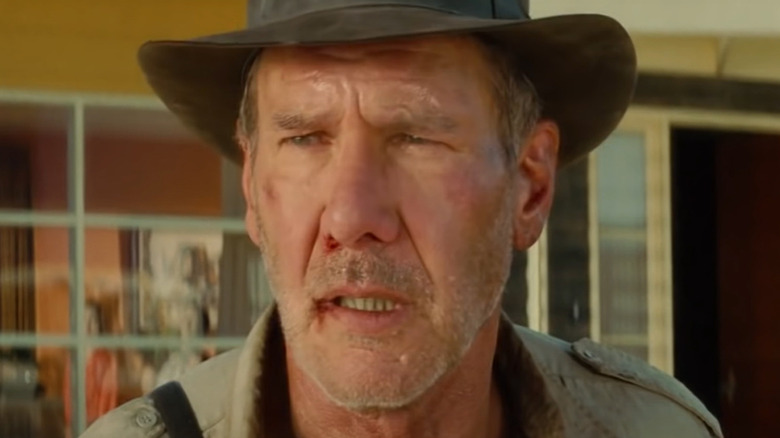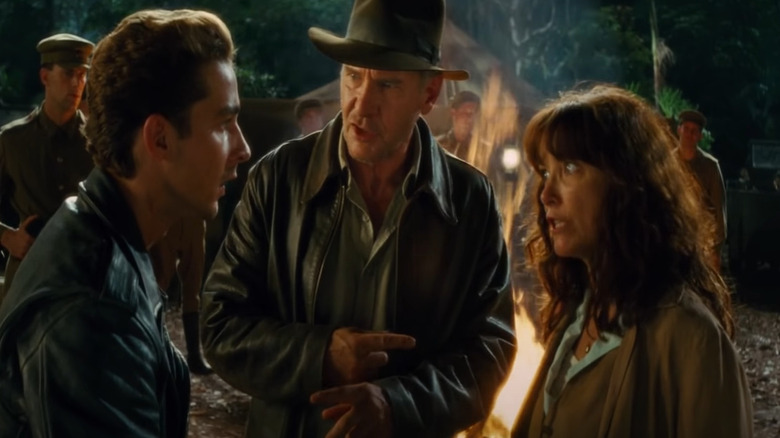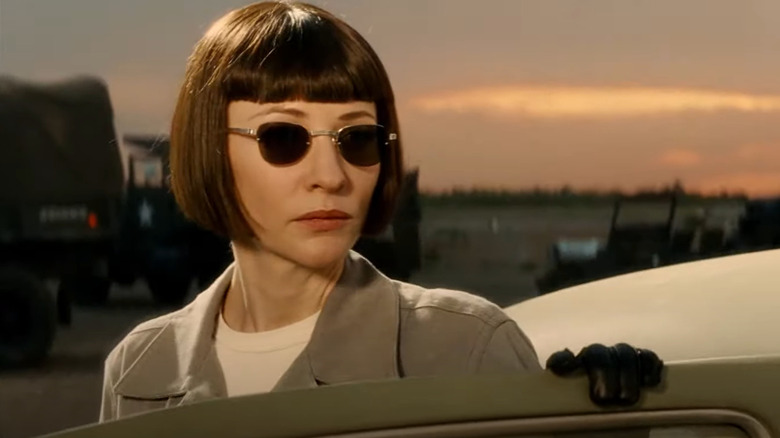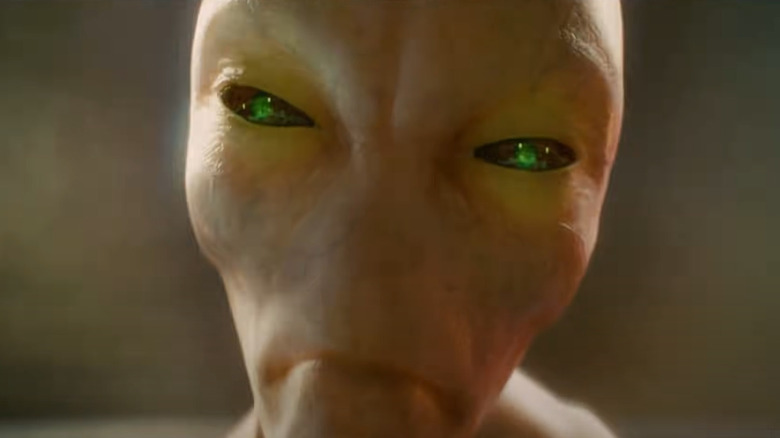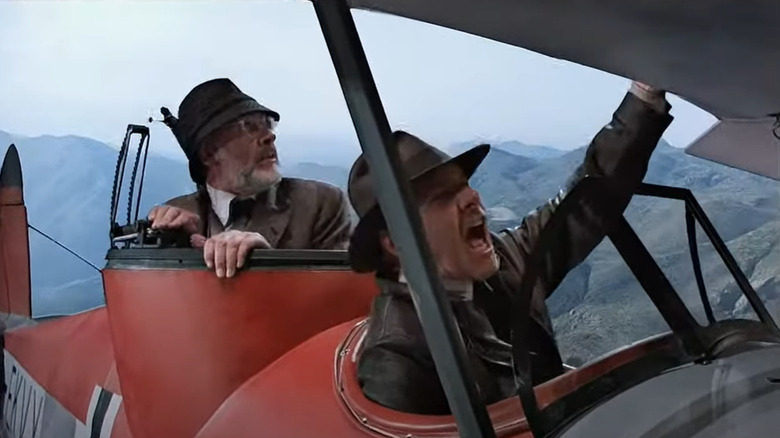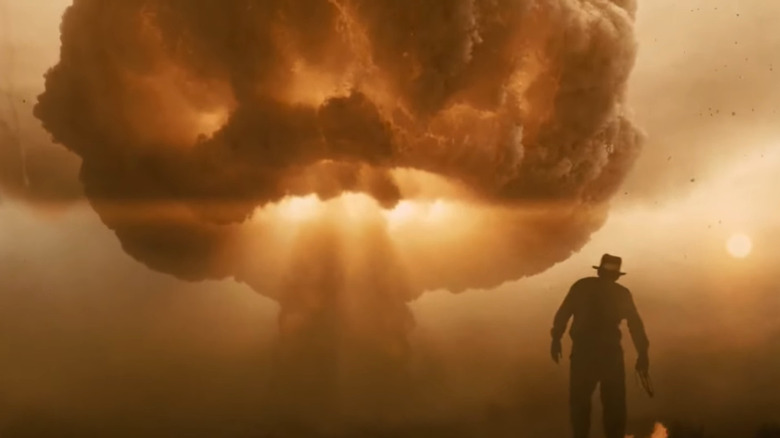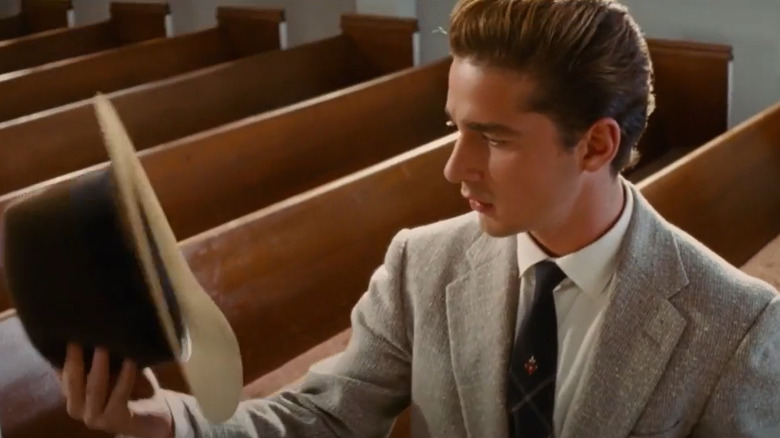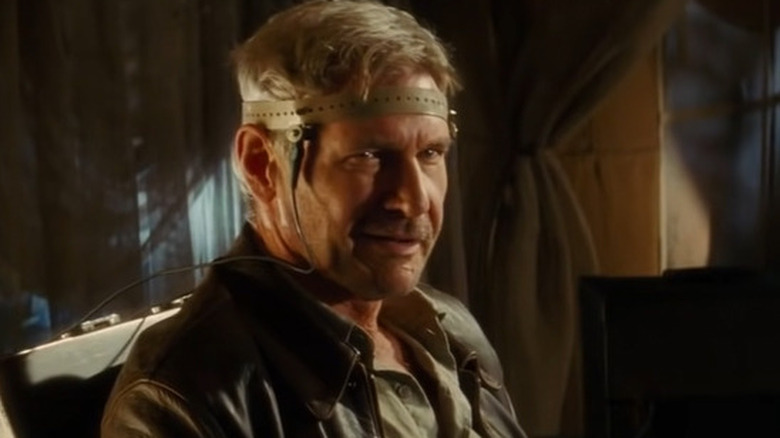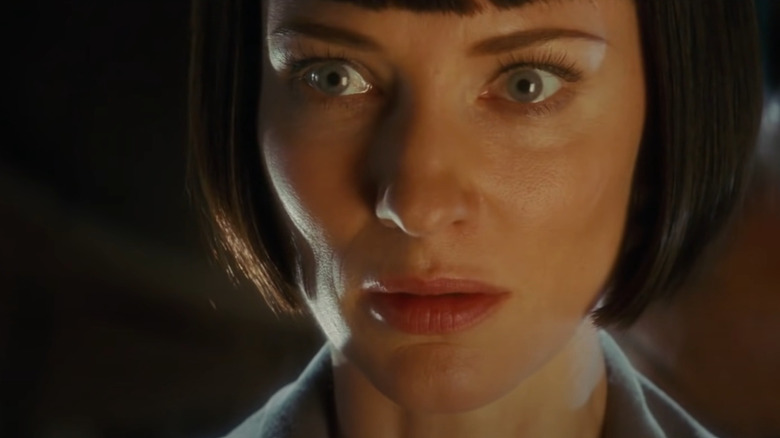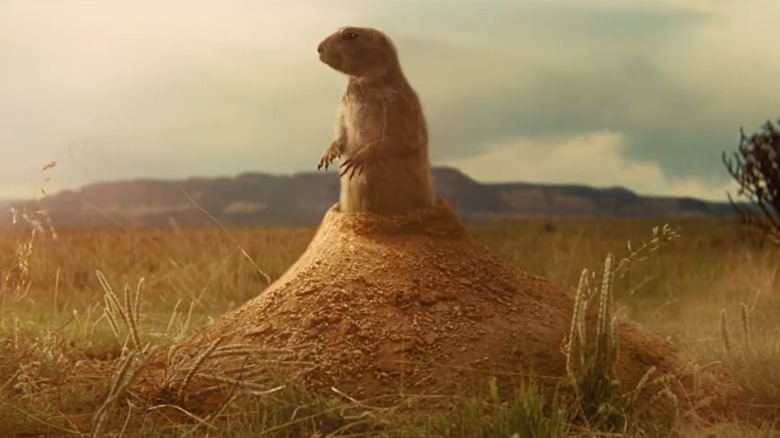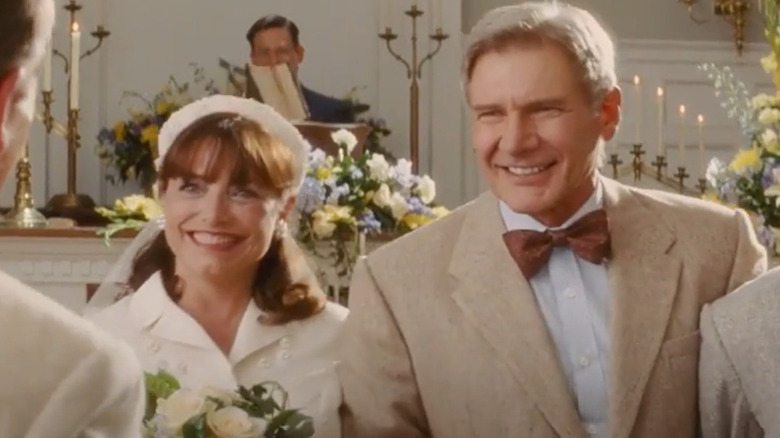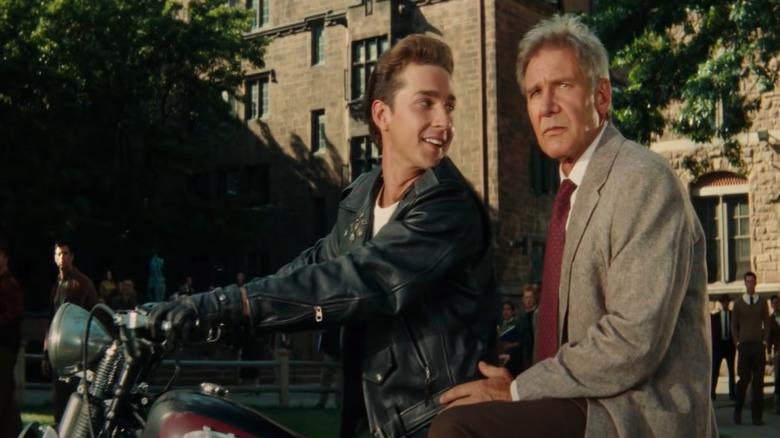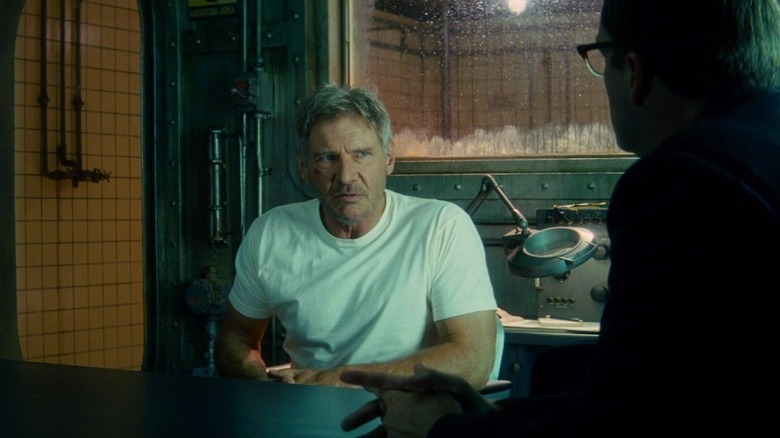How Indiana Jones: Kingdom Of The Crystal Skull Changed The Franchise Forever
The "Indiana Jones" films are some of the most iconic and beloved movies in cinema history. Uniquely, they manage to incorporate a wide variety of genres including action, fantasy, romance, and horror, meaning there's something in these movies for everyone. To top it off, Harrison Ford's portrayal of the titular adventurer has resonated with audiences for over 40 years. Moviegoers never tire of watching him pursue legendary treasures across the globe.
While the "Indiana Jones" franchise is not without its glaring missteps, it never fails to provide viewers with something new and compelling in each installment. Whether it's introducing new themes or building on old ones in innovative ways, "Indiana Jones and the Kingdom of the Crystal Skull" is absolutely no exception. In celebration of this success, we're rounding up some of the biggest ways in which the fourth "Indiana Jones" film changed the future of the franchise for good.
Indiana Jones is now a father
There are many ways in which Indiana Jones is a great role model — consider his unmatched bravery in the face of danger, or his incredible charm and charisma — but being an ideal father figure probably isn't one of them. Although he does do right by most people he meets, his long journeys spent in far-flung regions of the world, combined with his penchant for finding himself in dangerous situations, don't exactly scream family man. Nevertheless, after his mother Marion is kidnapped by Soviet agents, Indy's son Mutt (Shia LaBeouf) seeks out the famed archeologist, who happens to be his father. Crucially, Indy does not know of Mutt's paternity at this point in time.
Soon after the unlikely family comes together, Marion reveals that Mutt is Indy's son. Although we've seen Indiana Jones teaming up with many unexpected allies, including his much-younger sidekick Short Round in "Temple of Doom," the father-son relationship is a new one. This new addition to the continuing story is enormously entertaining.
It takes place in a paranoid world
The time skip between "The Last Crusade" and "Kingdom of the Crystal Skull" is the largest in the series, propelling the story forward nearly 20 years. This huge leap is reflected in both Indy's character and the world around him. Here, Indy is older, wiser, and more experienced, while the Cold War has brought entirely new complications to the global stage. Tensions are high at home and abroad, and the fear of communism is running rampant across American society. Protests and paranoia are increasingly commonplace.
This anxious attitude isn't confined to the United States — both sides of the Cold War are doing whatever it takes to win the struggle. Indeed, the Soviet Union is attempting to harness the powers of the crystal skull to blanket the world in their ideals. This plot draws the attention of FBI agents, who are so distrustful, they even suspect Indy of collaborating with the Russians. While these attempts at world domination are foiled, the themes of international espionage and bombastic propaganda it introduces are likely here to stay for any future "Indiana Jones" stories.
The introduction of aliens
All of Indy's prior adventures see him search for relics that possess various mystical properties. The key word there is "mystical" — from the Ark of the Covenant to the Holy Grail, these treasures always owe their powers to their fantastical nature. "Kingdom of the Crystal Skull" breaks from this norm with the titular crystal skull and its intriguing origins.
Basically, the crystal skull doesn't have power through spiritual means, but because of its off-world origin. The skull belongs to aliens — specifically, interdimensional beings. While some might argue this prevents them from being considered true aliens, what's clear is that their existence changes the franchise forever. These entities are firmly science-fictional, rather than fantastic, and thus introduce a new genre to these films. Their arrival offers a plethora of potential directions the series could pursue, from interdimensional treasure-hunting to time-travel plotlines. The sky's the limit for Indy's future escapades, thanks to these bizarre beings.
Indiana Jones was a WWII hero
The rise of Adolf Hitler and the Nazi Party is a central theme in the first and third "Indiana Jones" films, which see Indy repeatedly clash with the Germans as they attempt to seize the Ark of the Covenant and the Holy Grail. It's only natural that Indy would go on to help fight in World War II following the events of "The Last Crusade".
When the FBI interrogates Indy after his first encounter with the Russians at the start of "Kingdom of the Crystal Skull," they shed some light on his military service. It's revealed that he worked in military intelligence during the war, and was even awarded a number of medals. Indy's friend George McHale also illuminates his wartime experiences. Despite their long history together, George is seemingly revealed to be a double agent, working for the Russians. As the plot progresses, however, it becomes clear that even George isn't sure what side he's truly loyal to anymore. While it's not explicitly stated, the bond that formed between him and Indy during the war is part of what keeps him tied to the American side, even after his allegiance has been compromised by the Russians.
Bigger threats in a bigger world
Save for the occasional artifact with otherworldly powers, the majority of threats Indiana Jones has to fight are conventional weapons and the enemies who wield them. Swords, guns, and spears make up most of the dangers he faces. However, Indy's near-death run-in with the Russians at the start of "Kingdom of the Crystal Skull" makes it dramatically clear that times have changed, and so have the threats he encounters.
While fleeing from the pursuing Soviets, Indy ducks into what he quickly finds out is a live nuclear testing site. Though he narrowly escapes death, the results of the bomb's detonation highlight the fact that the most powerful weapons of the modern age dwarf any of Indy's prior archeological discoveries. Moreover, while a single nuclear weapon can achieve widespread devastation on a level that surpasses anything we've seen so far, the crystal skull might just be the only thing that can come close. The skull's mind control powers are so strong, it could potentially be used to brainwash an entire population into subservience, causing the Soviet Union to take a keen interest in the supernatural object.
Setting up Mutt to take after his father
Growing up, Indiana Jones had a strained relationship with his father, as shown in the opening scene of "The Last Crusade." This caused him to become increasingly independent at a young age, which saw him gain a taste for adventure and a passion for archeological rarities. On one of these early adventures, he acquired his signature fedora from a rival.
Much like his father, Mutt Williams has grown up without a paternal figure in his life. This has made him a self-reliant person who carves his own path through the world. Despite the tensions that exist between him and Indy, they're able to reconnect over the course of "Kingdom of the Crystal Skull" and make up for lost time. At the film's conclusion, it is suggested that Mutt may soon take up Indy's look and lifestyle when his fedora blows off a coat rack and lands at Mutt's feet ... before he's comically snubbed by his father snatching the hat back. While it doesn't look like actor Shia LaBeouf will be reprising his role as successor to the famous adventurer in the upcoming "Indiana Jones" film, the potential is still there for him to follow in his father's footsteps.
Mixed feedback means new filmmakers
Most fans agree that the "Indiana Jones" films can be a bit inconsistent when it comes to quality — so much so that even director Steven Spielberg has weighed in on the topic. The franchise incurred particularly intense criticism regarding the portrayal of India in "Temple of Doom." "Kingdom of the Crystal Skull" also earned mixed reviews (albeit for very different reasons), leaving the series in the lurch.
While we can expect to see a continuation of the story arrive in 2023, the creative minds working behind the scenes will be very different from those of previous films — a fact that seems to be due, at least in part, to the controversial legacy "Kingdom of the Crystal Skull" has left behind. As Collider reported in 2020, the fifth film in the "Indiana Jones" series will be directed by James Mangold, whose respectable filmography includes "Ford V Ferrari," "Logan," and "Walk the Line." Although the upcoming film won't be made by the exact same creative geniuses that brought us the classic "Indiana Jones" films, it will be exciting to see what direction Mangold's vision will take the series in.
The Soviet Union is now a major antagonist
One of the many reasons the "Indiana Jones" series is beloved is its memorable antagonists. We watch our hero face off against a wide range of villains, from Nazis and rival archeologists to gangsters and deranged cultists. No matter the adventure, there's never a shortage of foes standing between Indy and his goals. With "Kingdom of the Crystal Skull" bringing the story nearly two decades forward, new adversaries were needed. Enter the Soviet Union.
The Soviet Union's efforts to gain a tactical edge over the United States by any means necessary mirror those of the Nazis in their search for the Ark of the Covenant in "Raiders of the Lost Ark." Yet the introduction of the USSR also brings brand new menace to the series. The rising tensions between the United States and the Soviet Union play out in far more shadowy ways — this was, after all, a cold war. With "Kingdom of the Crystal Skull" being set in 1957, the franchise is also able to further explore the Soviet Union's efforts to counter Indiana Jones in future installments. Whether they will once again attempt to wield power beyond their control or attempt to get revenge on Indy for the events in Akator remains to be seen.
Changing the tone of the series
The spirit of adventure is the core of the "Indiana Jones" franchise. This essence is interpreted through humor, heart, and, perhaps most crucially, peril. Though things never become too dark, the original three films don't shy away from showing some truly brutal on-screen deaths, which make the stakes clear as well as provide Indy's character with believable grit. Some particularly stand-out moments include the time Indy lets a Nazi soldier get torn to pieces by an incoming propeller blade, or when Mola Ram rips out the heart of one of his victims.
In many ways, the fourth film is a noticeable tonal shift for the series. While "Kingdom of the Crystal Skull" does have its fair share of intense scenes, they're not quite as shocking as what happens in previous films. Many of them even border on comical, which makes the film feel even more like an exception to the franchise's rule. While this may be due to the filmmakers' desire to tell a more palatable story, it can also be seen as a reflection of the fact that aging Indy is losing his edge in the world.
Indiana Jones, married man
Indiana Jones is rarely seen without a companion on his globetrotting adventures, though they don't always turn out to be trustworthy. The most notable, and certainly the most like the whip-wielding relic hunter, is his old lover, Marion Ravenwood (Karen Allen). Her intelligence, quick wit, and ability to beat almost anyone in a drinking contest mirror Indy's grit and charm.
Their relationship is rocky, to say the least, as evidenced by Marion immediately hitting him when they reunite in "Raiders of the Lost Ark." It's obvious she holds a grudge against Indy for disappearing from her life years prior. Although she isn't seen for a while after that debut film, she reappears in "Kingdom of the Crystal Skull". To Indy's surprise, the duo find themselves in Brazil, in the Russians' custody. As they continue on their journey to unravel the secrets of the crystal skull, the pair bonds over their son, Mutt. By the end of the film, they find themselves happily married at last. The union might be several decades in the making, but it still marks a completely new chapter in Indy's life.
Indiana Jones makes room for other characters
One of the most interesting elements that "The Last Crusade" adds to the "Indiana Jones" franchise is the introduction of Indy's father, Henry Jones Sr., played by the late Sean Connery. Their father-son dynamic is a major part of the film, and adds a new level of depth to Indy's character. The two characters frequently find themselves at odds with each other, with Indy still harboring some resentment against his father. Happily, they manage to reconcile by the film's conclusion.
While Indy's father passes away between "The Last Crusade" and "Kingdom of the Crystal Skull," Indy ends up taking after the late Henry Jones in many ways. Much like Henry serves as a mentor to his son in "The Last Crusade," Indy finds himself acting as an advisor to Mutt, who is in desperate need of guidance. Despite his shortcomings, it becomes obvious that Mutt has his father's adventurous spirit, tagging along with him and the rest of the group in their search for Akator. Ultimately, he lives up to his family's legacy of bravado, guts, and love of the unknown. To a small but significant degree, this reduces Indy's prominence as the main character. He's no longer the only adventurer in the spotlight — and that's not necessarily a bad thing.
Tensions between Indy and the government
Although he tends to act as a lone wolf, Indy is occasionally aided by the United States government. It's only after Army Intelligence officers reach out to Indy to crack a Nazi code in "Raiders of the Lost Ark" that the plot to control the Ark of the Covenant is revealed. Despite this amicable history, this relationship sours after the FBI accuses the venerable Dr. Jones of collaborating with the Russians in "Kingdom of the Crystal Skull." This results in Indy losing his job as a university professor.
While Indy is ultimately cleared of all suspicion by the film's conclusion, this action sets a new precedent in the "Indiana Jones" universe, with the potential to explore bad actors within the American government. Rampant fears of communist influence in an increasingly distrustful world mean we could even see Indy have to prove his loyalty to the United States once again. Things aren't as clear-cut as they used to be, as Indy finds out the hard way.
